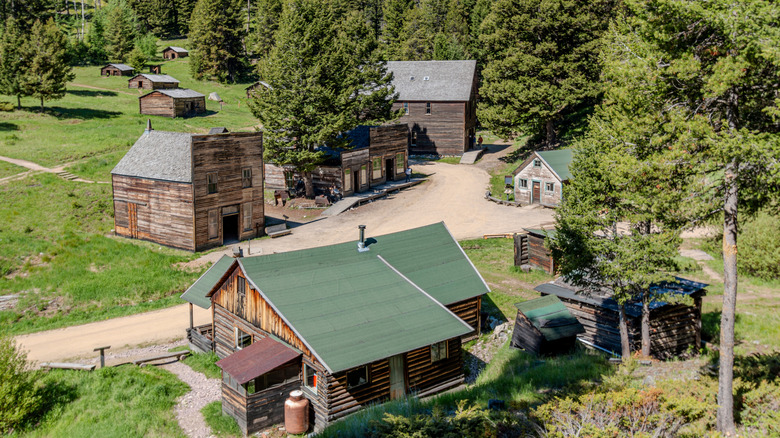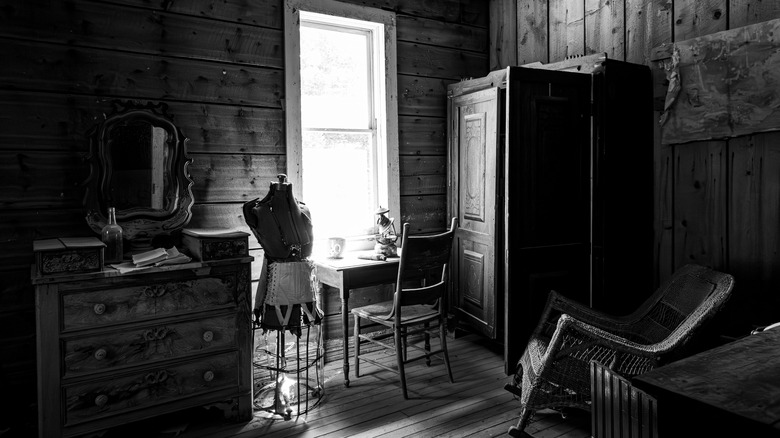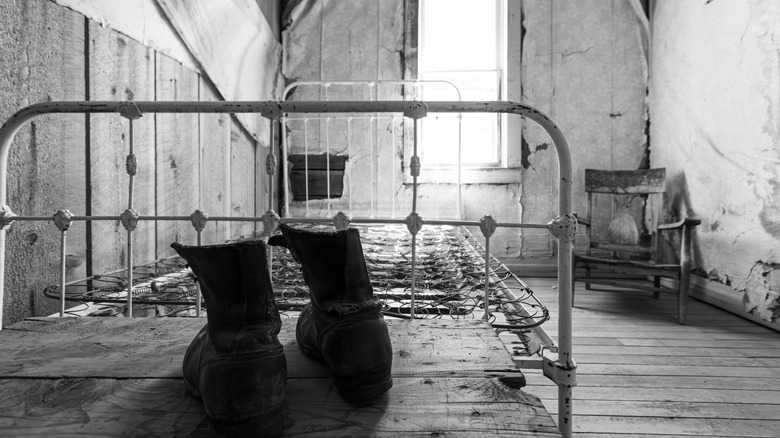Montana's 'Best Preserved Ghost Town' Was A Once-Thriving Mining Spot In The Heart Of Majestic Mountains
Nestled up high in the heart of an expansive, pine-covered mountain range is the long-abandoned Garnet, Montana's self-proclaimed "best preserved ghost town." Founded in the late 1800s, this once-thriving mining spot boasted four hotels, 13 saloons, three stables, two barber shops, a school, and more in its heyday. Its name, along with that of the surrounding mountains, is derived from the ruby-colored stones that were found dotting the area. Unlike most ghost towns, Garnet was abandoned and occupied multiple times, until its last known resident, widowed saloon owner Marion Dahl, left permanently in the 1960s. At its height, in early 1898, almost 1,000 residents called Garnet home.
The town is located in west Montana, known as the Treasure State. This moniker comes from the wealth that was discovered — gold, silver, copper, and sapphire, among others — and quickly extracted from the mineral-rich land. One of the northernmost states in what is considered the Wild West, Montana has over 300 ghost towns (according to researcher Terry Halden). Traces of most are gone, laid to waste after the miners' exodus. However, Garnet is one still-intact site that can be visited, along with other historic gems like Nevada City, an abandoned Montana mining town with vintage steam trains, and Granite, located just outside of an enchanting mountain town halfway between Yellowstone and Glacier National Park. While each ghost town retains its own unique history and special charm, they are all remnants of a bygone era and a testament to the settlers' ingenuity and resilience. A visit to Garnet is a chance to experience living history and to walk in the footsteps of its intrepid settlers, most of whom eked out a difficult existence in the hopes of finding both adventure and fortune in the depths of these majestic mountains.
The history (and haunting) of Garnet Ghost Town
The town of Garnet grew around a mill that was set up in 1895 to process ore. After an ore-rich vein was struck, miners flocked to this area by the hundreds to try their luck panning for gold. Businesses opened and flourished, providing amenities and much-needed services to the residents. Alcohol flowed freely at the many drinking establishments, including the two-story Kelley's Saloon, where women chatted on the top floor, and men gambled and drank below.
By 1905, however, as the gold dried up, only around 150 residents remained. Then, a tragic fire swept through Garnet in 1912, devastating half of the buildings and causing even more of the inhabitants to depart. From then on, the population ebbed and flowed; gold became more valuable and drew people in, while the First and Second World Wars brought people out. By the 1940s, the town was almost entirely deserted, save for a few stubborn holdouts, including Dahl. It was listed on the National Register of Historic Places in 2010, with its 80-plus still-standing structures registered as the Garnet Historic District.
As with any abandoned town, rumors of paranormal activity and unexplained phenomena abound. In "Montana Chillers," Ellen Baumler, author and historian, writes, "Sometimes, in the deep winter quiet, a piano tinkles in Kelley's Saloon and the spirits dance to ghostly music. Men's voices echo in the empty rooms. ... [Ghosts] hide in the shadows, laugh in the wind, and come out when you least expect them." Over the years, there have also been reports of phantom figures gazing out of windows, doors slamming, and mysterious footprints.
So is Garnet actually haunted? Some ghost hunters say yes. But you'll have to pay this town a visit and find out for yourself.
Planning your visit to Garnet Ghost Town
Head to Garnet to take a meaningful journey back in time. Stop by the J.R. Wells Hotel, owned by the Wells family, a once-grand affair with stained-glass windows and an impressive oak staircase that hosted town events and newly-arrived settlers. Walk through abandoned businesses, including the blacksmith shop and F.A. Davey's, a no-nonsense general store selling supplies and goods. In the (potentially haunted) Kelley's Saloon, imagine weather-wizened men, exhausted from a day of fruitless labor, commiserating over hard spirits and a game of poker.
Step along the creaky wooden slats of the miners' cabins and take in the peeling wallpaper, rustic furnishings, and old earthenware to get a glimpse of early homesteader life. You might be surprised at the size of some of the cabins if you have frequented other ghost towns — miners both lived and worked here, and as a result, Garnet was more family-friendly than other towns. Some residents built homey, multi-room houses, warmed only by small wood-burning stoves, and filled them with toys, furniture, and other personal effects.
Garnet Ghost Town can be found around 40 miles east of Missoula, a cozy Montana city with snow-capped beauty and charm, and it sits at around 6,000 feet above sea level. At the time of writing, tickets costs $10 for adults, while children 16 years and under can enter for free. Garnet's commercial buildings open up from 9:30 a.m. to 4:30 p.m. every day, but the visitor center is only open from late May until the end of September — note that weather conditions can make accessibility a challenge, as the route into town is steep and narrow. Vehicles are allowed on the road between May 1 and December 15, but during winter, the town can only be reached by skis or snowmobiles.


